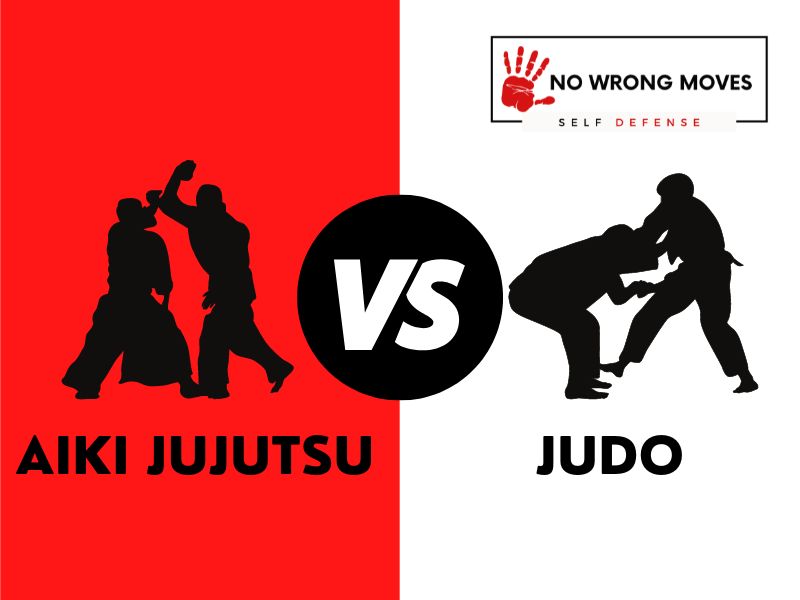
- What We Know About Aiki Jujutsu
- What We Know About Judo
- Key Elements Of Aiki Jujutsu
- Key Elements Of Judo
- Aiki Jujutsu Rankings & Levels
- Judo Rankings & Levels
- Aiki Jujutsu Vs. Judo Attire
- What A Typical Aiki Jujutsu Training Session Looks Like
- What A Typical Judo Training Session Looks Like
- Aiki Jujutsu Movies
- Conclusion: Aiki Jujutsu Vs. Judo
Today, we are going to end the long-standing debate of Aiki Jujutsu Vs. Judo! People (especially those online) go back on forth on which discipline is better. Some say that Aiki Jujutsu is more fluid and instinctive, while others argue that Judo is more powerful and straightforward. So, which is it and why?
Well...
The main differences between Aiki Jujutsu and Judo are that Aiki Jujutsu emphasizes fluidity, natural movement, and the principle of using an opponent's force against them for greater advantage. Judo, on the other hand, is more linear and emphasizes strength and control.
Aiki Jujutsu is considered a more "complete" art because it includes throws, joint locks, pins, chokes, and other grappling techniques. Judo is mainly a throwing art with a small amount of ground grappling.
Aiki Jujutsu tends to be favored by people who are looking for a more fluid and versatile martial art that can be used in multiple situations. Judo is favored by people who want a competitive sport with a strong emphasis on throwing and ground control.
There isn't quite a clear answer as to which art is better though. It ultimately depends on the individual's goals and preferences.
But let's look at these two disciplines in more depth.
Once we've done that, yu can decide for yourself.
What We Know About Aiki Jujutsu
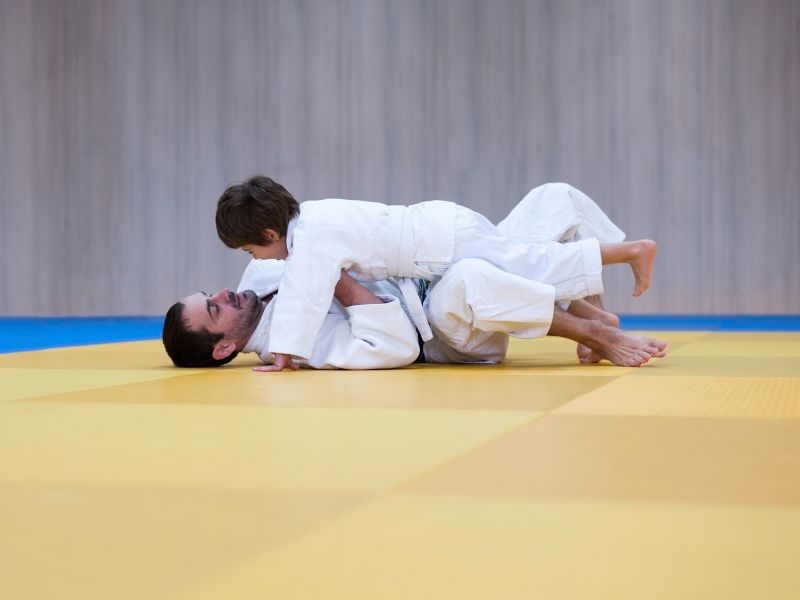
Aiki Jujutsu is a martial art that involves harmonizing your own energy with that of your opponent in order to redirect it in a way that suits your needs.
Instead of meeting force head-on, Aiki Jujutsu practitioners use Kempo-Jutsu's striking and evasive techniques to position themselves close to their opponents. They then follow up with linear, diagonal, or circular movements to redirect the opponent's energy.
Throwing techniques in Aiki Jujutsu rely heavily on Kempo-Jutsu's Atemi. In some instances, a skilled practitioner can apply Aiki Jujutsu throwing techniques by blending with their opponent's energy.
Aiki Jujutsu can be traced back to the Takenouchi Hisamori's Shinmei-ryu school of swordsmanship, which he founded in the early 1600s.
His student, Takeda Sokaku, is credited with creating Aiki Jujutsu from the techniques he learned from Hisamori. Sokaku passed on his knowledge to his son, Takeda Tokimune, who then continued to develop and teach the art until his death in 1943.
The art was further refined by Morihei Ueshiba, who created Aikido, a modernized version of Aiki Jujutsu.
Even today, Aiki Jujutsu can be used for self-defense or as a form of physical and mental exercise. Its excellent teachings regarding control over one's body and mind have made it a staple in the martial arts community.
What We Know About Judo
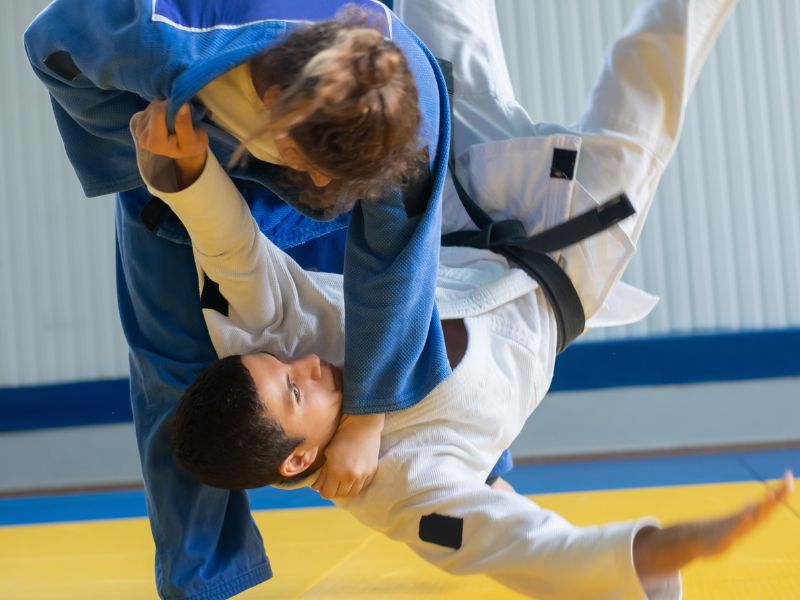
As the Meiji era began in 1868, Japan went through a modernization which led to a decline in the use of Jiu-Jitsu. This martial art had been practiced exclusively by the samurai class, who were losing their importance and power in Japan.
Jiu-jitsu was then associated with thugs and brawlers. However, one man saw potential in jiu-jitsu and decided to revive it.
That man was Jigoro Kano, who is considered the founder of Judo. Kano was born in 1860 into a family of samurai who had lost their status and power several generations earlier.
Despite this, he was able to attend Tokyo Imperial University, where he studied Western philosophy, literature, and science.
Kano believed that Jiu-Jitsu could be used for more than just fighting, and he set out to create a system that could be used for physical education, mental discipline, and character development.
In 1882, he founded the Kodokan Judo Institute, which is still in operation today. Judo has since become one of the most popular martial arts in the world.
Of course, this is only a brief history and understanding of Aiki Jujutsu and Judo, but if you want to go deeper into either art, be sure to check out the following posts:
Now, back to the comparison...
Let's look at the origins of the respective disciplines and then compare the key elements of their practices. You will be able to understand some of their similarities and differences a bit better afterward.
| Aiki Jujutsu | Judo | |
| Origins | Japanese |
Key Elements Of Aiki Jujutsu

One of the fundamental principles in Aiki Jujutsu is the use of leverage and balance to gain an advantage over one's opponent. This involves the strategic application of force and momentum to manipulate an opponent's body, making it easier to control and overpower them.
Another essential component of Aiki Jujutsu is the use of body movement and positioning.
By carefully positioning one's body in relation to the opponent, a practitioner can create openings for attacks or defensive maneuvers. This requires a high degree of spatial awareness and precision in movement.
Joint locks and throws are powerful techniques that can be used to subdue an opponent quickly and efficiently.
These maneuvers involve applying pressure to a joint or manipulating an opponent's balance to throw them to the ground. They require a thorough understanding of anatomy and a high degree of technical skill.
One of the most advanced techniques in Aiki Jujutsu is the ability to blend with the motion of an attacker. This involves moving in a way that allows a practitioner to avoid incoming attacks while simultaneously positioning themselves to counterattack.
It requires an acute awareness of an opponent's movements and a high level of skill in evasive maneuvers.
Next, up here in Aiki Jujutsu is breath control. By learning to regulate their breathing, practitioners can maintain their focus and energy levels, even in the face of physical exertion and stress.
Mental focus and calmness in the face of adversity are critical traits for any Aiki Jujutsu practitioner.
And speaking from personal experience, if you're knee deep into a fight, you'll want to know how to maintain a clear head and a calm demeanor, even in the face of obvious danger.
This requires mental fortitude and the ability to stay focused under pressure, the kind that Aiki Jujutsu will teach you.
Finally, one of the most powerful parts of this martial art is its ability to use an attacker's energy against them.
By skillfully redirecting an opponent's momentum, a practitioner can use their strength and force to overpower them. Of course, this requires a deep understanding of the techniques and a high degree of technical skill--which, trust me, your training will be able to give you in spades.
Key Elements Of Judo
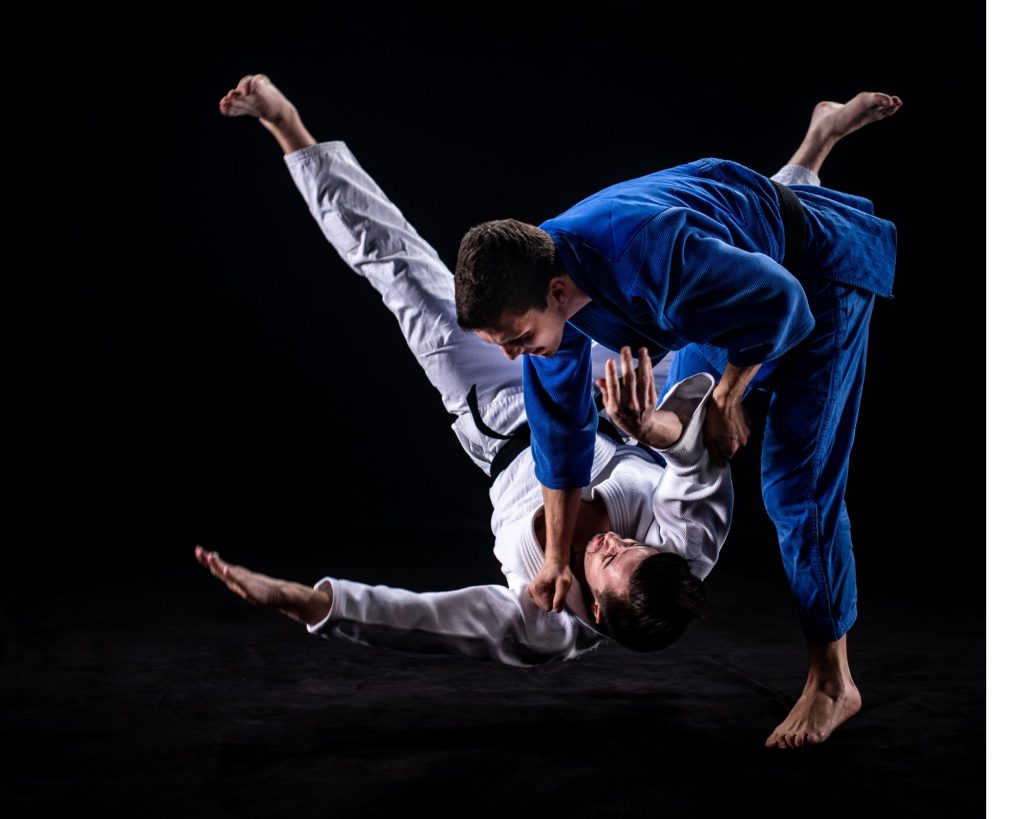
There are several key elements that make up Judo, each of which is crucial to mastering the art. One of the most important is maintaining proper stance and footwork. This allows a Judoka to move quickly and easily, while also providing a solid foundation for throwing techniques.
Another key element of Judo is gripping the opponent. A Judoka must know how to grip their opponent in a way that allows them to control their movements and set up throws.
Proper gripping technique is essential to success in Judo, as it can make the difference between a failed attempt and a successful throw.
Fundamental throwing techniques are also a crucial element of Judo. These techniques, such as hip throws and foot sweeps, allow a Judoka to off-balance their opponent and throw them to the ground.
Kuzushi, or off-balancing the opponent, is another key element of Judo. By breaking the opponent's balance, a Judoka can create an opening for a throw or other technique.
Proper use of momentum and strength is also important, as a Judoka must know how to use their own momentum and strength in combination with their opponent's to achieve their goals.
Timing and distance are also critical elements of Judo. A Judoka must know when to initiate an attack and when to wait for the right moment.
Finally, knowing when and how to finish a throw is a key element of Judo. Once a Judoka has successfully executed a throw, they must know how to control their opponent and avoid being thrown themselves.
Proper finishing technique is essential to successfully completing a throw and avoiding injury. Mastering all of these key elements is essential to becoming a successful Judoka.
Another thing I think is important to look at is the different rankings and levels in each art. if you are looking to take up either Aiki Jujutsu or Judo, whether as a hobbyist or to compete, you need to understand the different levels of proficiency and what is required for testing and ranking.
Aiki Jujutsu Rankings & Levels
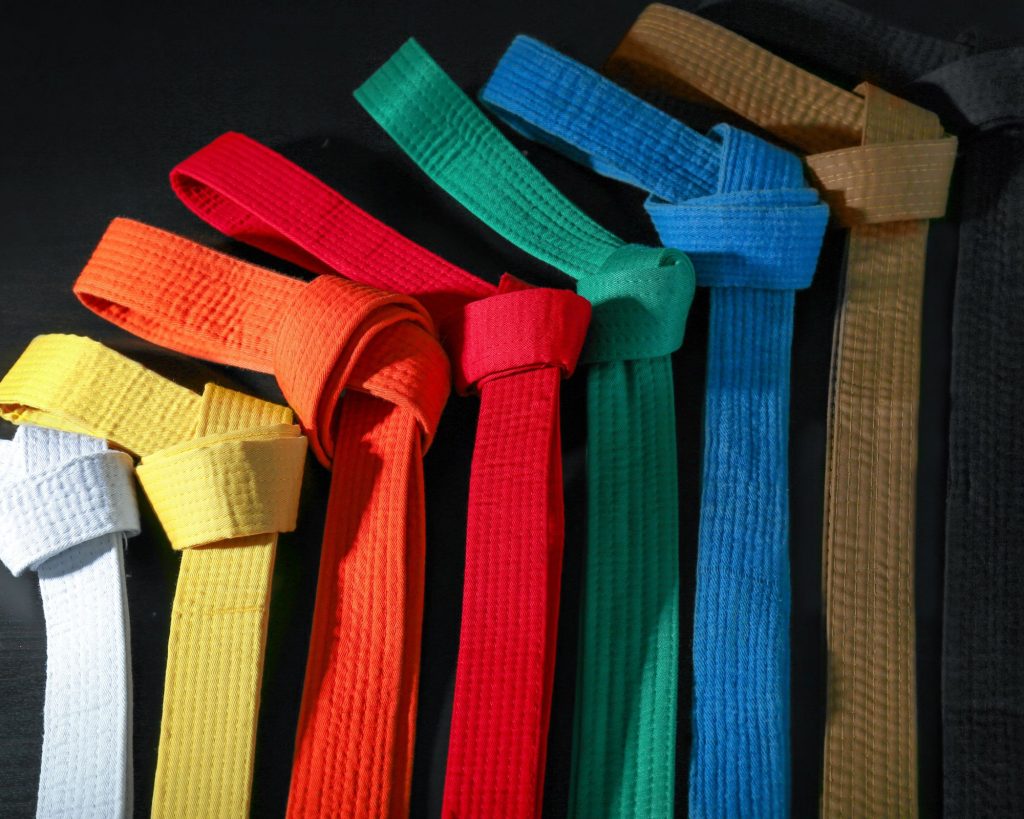
Aiki Jujutsu has its own ranking system, as you've likely already expected. It starts with the 10th Kyu white belt, which represents the beginner level. As one progresses, they move up the ranking system by earning colored belts and stripes.
The ranking system is divided into two categories: kyu and dan. Kyu represents the colored belts that one earns before reaching the black belt level. Dan represents the black belt levels.
The colored belt levels range from 9th Kyu white belt with a yellow stripe, all the way to 4th Kyu purple belt.
The amount of training required to earn these belts is pretty significant, in my opinion. IT ranges from 2 to 3 months, such as for the 9th Kyu white belt with a yellow stripe, to 15 to 21 months, like for the 4th Kyu purple belt.
The black belt levels start with the Shodan-Ho (Junior Black Belt) and progress to the highest level, which is the Godan (5th Degree Black Belt).
If you ask me, it's definitely not an easy feat to achieve: it normally takes years of dedication and training to reach the highest levels of the black belt ranking system.
If this is all a bit hard to visualize, don't worry; I've made a more detailed breakdown for you to see below:
| Rank | Color |
| 10th Kyu | White |
| 9th Kyu | White |
| 8th Kyu | Yellow |
| 7th Kyu | Blue |
| 6th Kyu | Green |
| 5th Kyu | Green |
| 4th Kyu | Purple |
| 3rd Kyu | Brown |
| 2nd Kyu | Brown |
| 1st Kyu | Brown |
| Shodan-Ho | Black |
| Shodan | Black |
| Nidan | Black |
| Sandan | Black |
| Yondan | Black |
| Godan | Black |
Judo Rankings & Levels
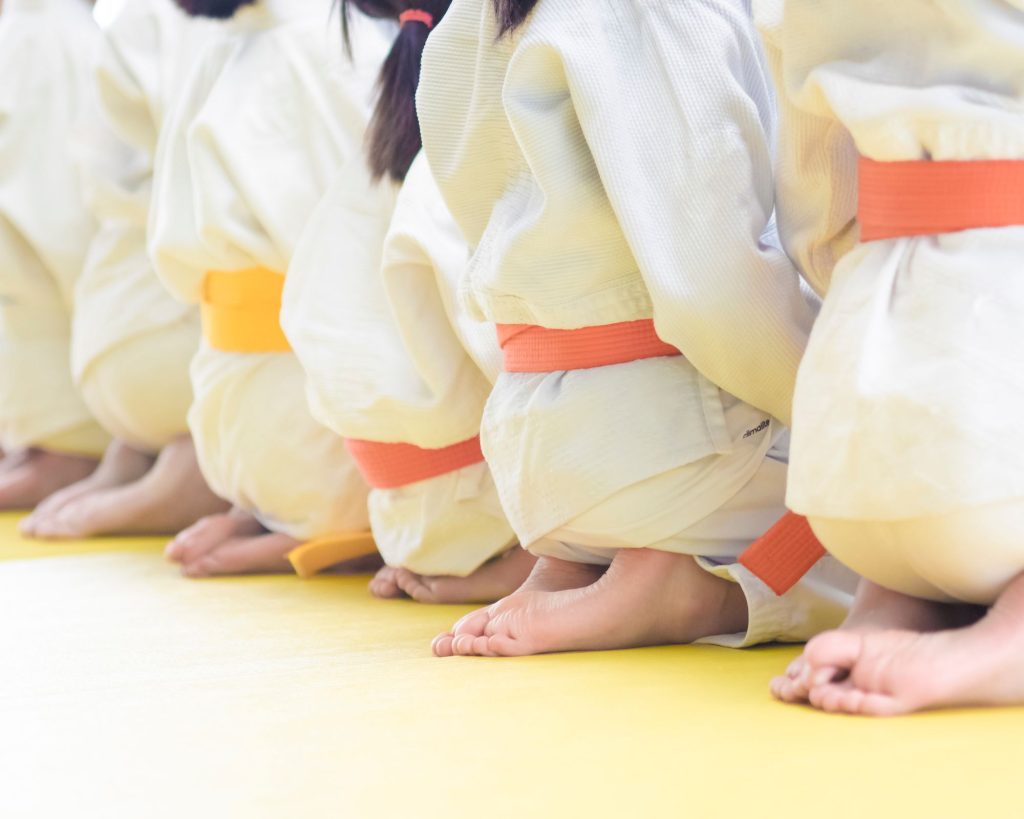
In the current Judo ranking system, students are placed into six descending numerical grades. Beginners start with the sixth kyū (六級, rokkyū) and wear a light blue belt until they attain an elementary level of instruction.
Once they've achieved this, they are promoted to the fifth kyū (五級, gokyū) and begin wearing a white belt. The white belt is worn until the fourth kyū (四級, yonkyū) is achieved.
The remaining three grades (third kyū (三級, sankyū), second kyū (二級, nikyū) and first kyū (一級, ikkyū) are all indicated with brown belts (for seniors) or purple belts (for juniors).
The first kyū (一級, ikkyū) is the final kyū rank before promotion to the first-degree black belt (shodan). The dan ranks, in practice, comprise of 10 levels, which are ranked in ascending numerical order.
Aiki Jujutsu Vs. Judo Attire
This section simply compares the clothing and uniforms that practitioners wear in combat.
Aiki Jujutsu Attire:
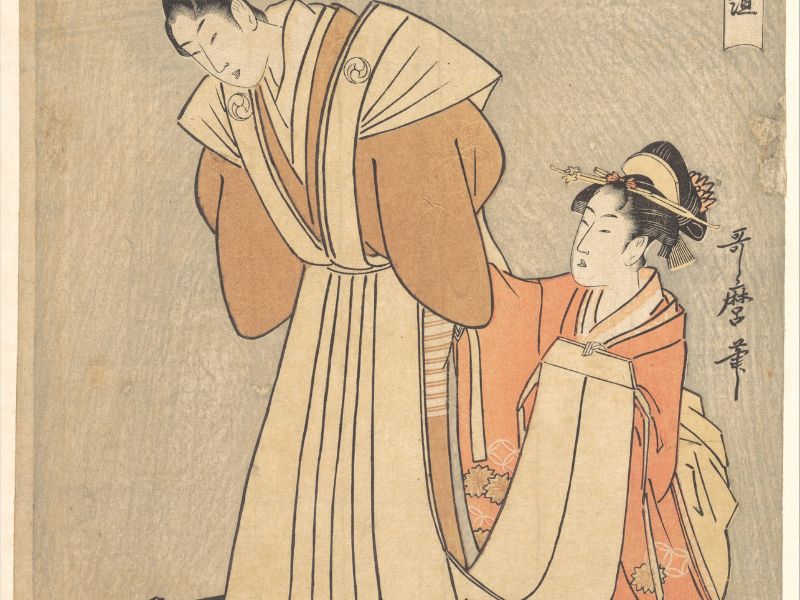
In terms of attire, Aiki Jujutsu practitioners typically wear a traditional dogi and hakama. This affords them better gripping and movement during techniques.
Judo Attire:
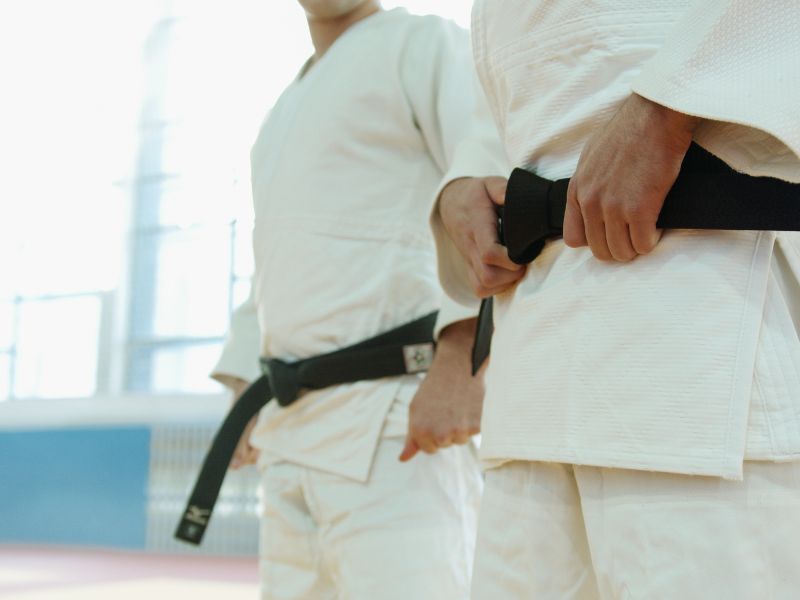
Judo practitioners wear a gi, which is a type of uniform made of heavy cotton fabric. The gi includes a jacket, pants, and a belt. In competition, the color of the belt indicates the practitioner's rank.
What A Typical Aiki Jujutsu Training Session Looks Like
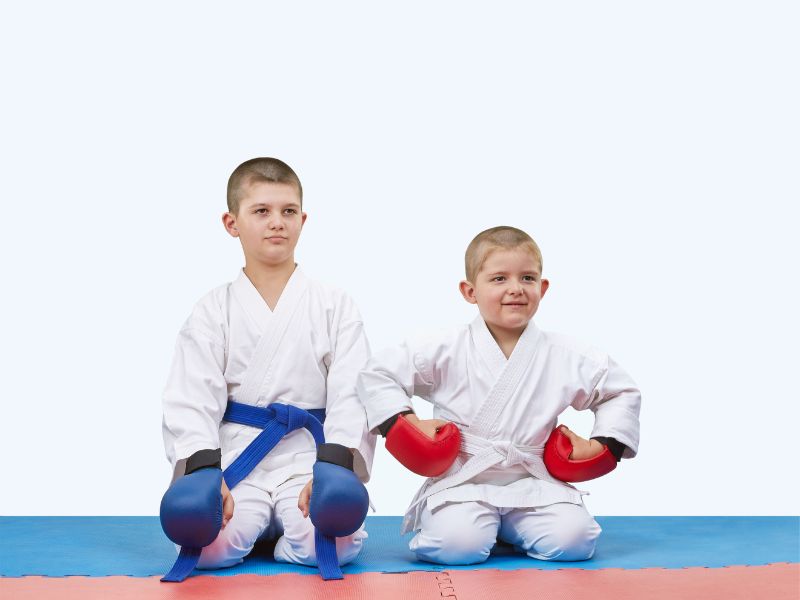
A typical Aiki Jujutsu practice session may start with a few minutes of warm-ups, such as joint rotations and light stretches. This is followed by practicing techniques, which may include throws, locks, and pins. The session usually ends with some relaxation exercises and a cool-down.
One of the most commonly used techniques in Aiki Jujutsu is the wristlock. This involves controlling an opponent's wrist and using their own momentum to throw them off balance.
In addition to physical technique, Aiki Jujutsu also emphasizes mental and spiritual development. This includes cultivating a strong mind-body connection and developing qualities such as patience and awareness.
What A Typical Judo Training Session Looks Like

Most judo classes will start with a warm-up. This usually consists of light calisthenics and stretching. The purpose of the warm-up is to get your body ready for the physical activity to come.
After the warm-up, you will learn various judo techniques. These may include throws, joint locks, and chokeholds. You will likely practice these techniques with a partner.
Next, randori. Randori is a type of free sparring that is common in judo. In randori, you and your partner will take turns attacking and defending. This is a good way to practice your techniques in a more realistic setting.
After that, kata are pre-arranged patterns of techniques that are performed with a partner. There are many different kata, each with its own specific purpose. Some kata are designed to teach self-defense, while others are designed to teach offensive techniques.
At the end of class, most instructors will have their students do a cool-down. This usually consists of light stretching and calisthenics. The purpose of the cool-down is to help your body recover from the physical activity it has just undergone
If the last few sections have been a bit full-on or a bit too technical, you will like this next section! Why? Because who doesn't love a good martial arts flick?
Both Aiki Jujutsu and Judo have been featured in a number of films and TV shows, so if you want to learn more about them, then entertain yourself with the following 👊
Aiki Jujutsu Movies

These are some of the top movies and shows with Aiki Jujutsu in them:
- The Bourne Identity (2002)
- Kill Bill: Volume 1 (2003)
- The Protector (2005)
- The Matrix Reloaded (2003)
- Ong Bak (2003)
And as for Judo, some of my top picks would be:
- Daredevil (TV series, 2015-2018)
- The Wolverine (2013)
- Arrow (TV series, 2012-2020)
- John Wick (2014)
- 13 Assassins (2010)
- The Raid (2011)
Conclusion: Aiki Jujutsu Vs. Judo
I hope you now have a deeper understanding of Aiki Jujutsu and Judo. In all truth, it is not about which discipline is "better" as they each have their pros and cons.
If you do plan on starting classes for either, please check out my other related posts, as I have tried my best to answer all the FAQs related to the art.
Feel free to share this post and any graphics you like, and of course, if you have any questions or thoughts, drop them below or shoot me an email, and I will be happy to assist 🙂
[author-box-jpx-fitness]
